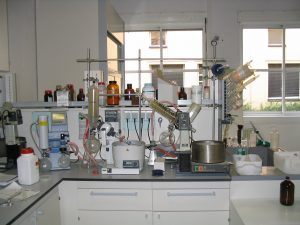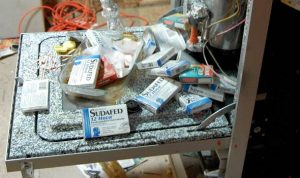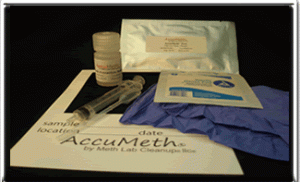 If walls could talk, do you know what your investment property would be saying? I think most of us probably cringe at the thought of what might have occurred at a property before we bought it, especially considering the condition in which we oftentimes find them. In most cases it’s easier to just follow the old adage, “out of sight, out of mind” and focus on the future of the property, and how to renovate it for the next owner. However, there is one activity from the past that, if ignored, could come back to haunt you.
If walls could talk, do you know what your investment property would be saying? I think most of us probably cringe at the thought of what might have occurred at a property before we bought it, especially considering the condition in which we oftentimes find them. In most cases it’s easier to just follow the old adage, “out of sight, out of mind” and focus on the future of the property, and how to renovate it for the next owner. However, there is one activity from the past that, if ignored, could come back to haunt you.
Unfortunately there is a new epidemic in our country of homes being used as meth labs, and it’s not just limited to the low income, high crime areas of town, as some would expect. The recent foreclosure crisis has created a glut of vacant homes around the country, and many of these properties are the perfect hideout for those looking to cook up their deadly concoction. If investors are not careful, they could get more than they bargained for when purchasing that distressed foreclosure property.
What’s the Big Deal?
The stigma from drug activity that accompanies a home can dramatically impact the value of the property, as well as  the value of homes nearby. In fact, a study presented in 2011 by researcher Joshua Congdon-Hohman, the assistant professor of economics at the College of the Holy Cross, found that this stigma and negative impact on value can extend to homes that are up to a half a mile away. Nearby homes can lose anywhere from 10-19% up to a year later when they are located close to a home where meth production was carried out.
the value of homes nearby. In fact, a study presented in 2011 by researcher Joshua Congdon-Hohman, the assistant professor of economics at the College of the Holy Cross, found that this stigma and negative impact on value can extend to homes that are up to a half a mile away. Nearby homes can lose anywhere from 10-19% up to a year later when they are located close to a home where meth production was carried out.
However, the problems with a former meth lab go far beyond just the possible stigma that could be attached to the house and surrounding area. In many of these drug-producing homes, the electrical wiring has been tampered with or compromised, which could be very expensive to replace. Depending on the size of the home and the level of contamination, the cost to remedy the faulty wiring could be up to $10,000 or more.
Of additional concern are the fumes and residue that are emitted as a result of the drug manufacturing process. These contaminants seep into the surfaces of a home, permeating many areas such as the insulation and drywall. The result of living in this poisonous environment can be the catalyst for a host of health problems for unsuspecting homeowners, ranging from respiratory illnesses to neurological problems that require serious medical treatment.
How Do You Know Whether a Home was a Meth Lab?
One of the most important aspects to determining whether your home was ever a meth lab is understanding what you can NOT rely on when it comes to normal home buying due diligence: property disclosure laws and home inspections. Potentially hazardous substances like asbestos, and radon are usually a state-based disclosure requirement, with the exception of lead-based paint, which is a federal mandate. At this time, however, only about 50% of states require both homeowners and realtors to disclose the history of known meth activity in houses that are on the market. So buyers beware in states like Florida, Tennessee, Michigan, and Georgia that have no disclosure requirements in place.
 Additionally, most home inspectors do not test for drug residue as a part of their standard home inspection. Though this is becoming more of a problem for investors and owner-occupants alike, it hasn’t quite reached the level of nationalized standards or federal regulations. Therefore, the onus is on the buyer to make the necessary inspections to protect their investment in a property.
Additionally, most home inspectors do not test for drug residue as a part of their standard home inspection. Though this is becoming more of a problem for investors and owner-occupants alike, it hasn’t quite reached the level of nationalized standards or federal regulations. Therefore, the onus is on the buyer to make the necessary inspections to protect their investment in a property.
The first and most obvious step is to inspect the home for any signs of the materials used to make crystal meth, such as boxes of cold medicine that contain ephedrine or pseudoephedrine, lye solution, filter cloths, etc. It’s also a good idea to talk to the neighbors, who will typically know the story behind what happened at the property before it became vacant. Recently I had a neighbor walk up to tell me that the recently renovated property down the street from my new purchase was a former meth lab, but thankfully that wasn’t the story behind my project.
Secondly, you can have a test conducted that will check for the presence of methamphetamine in the home. A professional test can cost you anywhere from $500-$700. However, there are numerous at-home tests on the market for as little as $25 that are capable of accurately testing whether these harmful chemicals reside on the various surfaces of the home.
Lastly, you can also search the DEA’s National Clandestine Laboratory Register to find any properties where meth labs have been discovered and identified by law enforcement. While your home’s absence from this list isn’t a guarantee it’s never been used in meth creation, if you find your potential investment on the website, you’ve guaranteed yourself a significant increase to your renovation budget.
In conclusion, while the existence of meth labs in a home is rare, it’s something that all investors should be aware of when analyzing a property for purchase. With foreclosures hitting an all-time high in the last few years, the glut of vacant homes has lured many bad actors into using these properties to produce illegal drugs. The number of meth labs has doubled and tripled in some locations, particularly in southern and Midwestern states, so it is wise to do some thorough investigation on any potential property for purchase. Always remember that a dime bag…erhhh, I mean an ounce of prevention is always worth a pound of cure, so perform your necessary due diligence to make sure your next investment is a home run!

Comments(0)